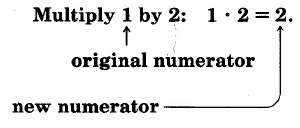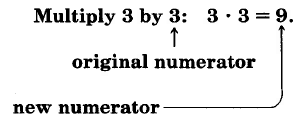5.2: Addition and Subtraction of Fractions with Unlike Denominators
- Page ID
- 48858
Learning Objectives
- be able to add and subtract fractions with unlike denominators
A Basic Rule
There is a basic rule that must be followed when adding or subtracting fractions.
A Basic Rule
Fractions can only be added or subtracted conveniently if they have like denominators.
To see why this rule makes sense, let's consider the problem of adding a quarter and a dime.
\(\text{1 quarter + 1 dime = 35 cents}\)
Now,
\(\left \{ \begin{array} {r} {\text{1 quarter } = \dfrac{25}{100}} \\ {\text{1 dime } = \dfrac{10}{100}} \end{array} \right \} \text{ same denominations}\)
\(35, \cancel{c} = \dfrac{35}{100}\)
\(\dfrac{25}{100} + \dfrac{10}{100} = \dfrac{25 + 10}{100} = \dfrac{35}{100}\)
In order to combine a quarter and a dime to produce 35¢, we convert them to quantities of the same denomination.
Same denomination \(\rightarrow\) same denominator
Addition and Subtraction of Fractions
Least Common Multiple (LCM) and Least Common Denominator (LCD)
In [link], we examined the least common multiple (LCM) of a collection of numbers. If these numbers are used as denominators of fractions, we call the least common multiple, the least common denominator (LCD).
Method of Adding or Subtracting Fractions with Unlike Denominators
To add or subtract fractions having unlike denominators, convert each fraction to an equivalent fraction having as a denominator the least common denominator ( LCD) of the original denominators.
Sample Set A
Find the following sums and differences.
\(\dfrac{1}{6} + \dfrac{3}{4}\). The denominators are not the same. Find the LCD of 6 and 4.
\(\left\{ \begin{array} {c} {6 = 2 \cdot 3} \\ {4 = 2^2} \end{array} \right \} \text{ The LCD = } 2^2 \cdot 3 = 4 \cdot 3 = 12\)
Write each of the original fractions as a new, equivalent fraction having the common denominator 12.
\(\dfrac{1}{6} + \dfrac{3}{4} = \dfrac{}{12} + \dfrac{}{12}\)
To find a new numerator, we divide the original denominator into the LCD. Since the original denominator is being multiplied by this quotient, we must multiply the original numerator by this quotient.
\(12 \div 6 = 2\)

\(12 \div 4 = 3\)

\(\begin{array} {rcll} {\dfrac{1}{6} + \dfrac{3}{4}} & = & {\dfrac{1 \cdot 2}{12} + \dfrac{3 \cdot 3}{12}} & {} \\ {} & = & {\dfrac{2}{12} + \dfrac{9}{12}} & {\text{ Now the denominators are the same.}} \\ {} & = & {\dfrac{2 + 9}{12}} & {\text{ Add the numerators and place the sum over the common denominator.}} \\ {} & = & {\dfrac{11}{12}} & {} \end{array}\)
Sample Set A
\(\dfrac{1}{2} + \dfrac{2}{3}\). The denominators are not the same. Find the LCD of 2 and 3.
\(\text{LCD} = 2 \cdot 3 = 6\)
Write each of the original fractions as a new, equivalent fraction having the common denominator 6.
\(\dfrac{1}{2} + \dfrac{2}{3} = \dfrac{}{6} + \dfrac{}{6}\)
To find a new numerator, we divide the original denominator into the LCD. Since the original denominator is being multiplied by this quotient, we must multiply the original numerator by this quotient.
\(6 \div 2 = 3\) Multiply the numerator 1 by 3.
\(6 \div 2 = 3\) Multiply the numerator 2 by 2.
\(\begin{array} {rcl} {\dfrac{1}{2} + \dfrac{2}{3}} & = & {\dfrac{1 \cdot 3}{6} + \dfrac{2 \cdot 3}{6}} \\ {} & = & {\dfrac{3}{6} + \dfrac{4}{6}} \\ {} & = & {\dfrac{3 + 4}{6}} \\ {} & = & {\dfrac{7}{6} \text{ or } 1 \dfrac{1}{6}} \end{array}\)
Sample Set A
\(\dfrac{5}{9} - \dfrac{5}{12}\). The denominators are not the same. Find the LCD of 9 and 12.
\(\left \{ \begin{array} {l} {9 = 3 \cdot 3 = 3^2} \\ {12 = 2 \cdot 6 = 2 \cdot 2 \cdot 3 = 2^2 \cdot 3} \end{array} \right \} \text{ LCD} = 2^2 \cdot 3^2 = 4 \cdot 9 = 36\)
\(\dfrac{5}{9} - \dfrac{5}{12} = \dfrac{}{36} - \dfrac{}{36}\)
\(36 \div 9 = 4\) Multiply the numerator 5 by 4.
\(36 \div 12 = 3\) Multiply the numerator 5 by 3.
\(\begin{array} {rcl} {\dfrac{5}{9} - \dfrac{5}{12}} & = & {\dfrac{5 \cdot 4}{36} - \dfrac{5 \cdot 3}{36}} \\ {} & = & {\dfrac{20}{36} - \dfrac{15}{36}} \\ {} & = & {\dfrac{20 - 15}{6}} \\ {} & = & {\dfrac{5}{36}} \end{array}\)
\(\dfrac{5}{6} - \dfrac{1}{8} + \dfrac{7}{16}\). The denominators are not the same. Find the LCD of 6, 8, and 16
\(\left \{ \begin{array} {l} {6 = 2 \cdot 3} \\ {8 = 2 \cdot 4 = 2 \cdot 2 \cdot 2 = 2^3} \\ {16 = 2 \cdot 8 = 2 \cdot 2 \cdot 4 = 2 \cdot 2 \cdot 2 \cdot 2 = 2^4} \end{array} \right \} \text{ The LCD is} = 2^4 \cdot 3 = 48\)
\(\dfrac{5}{6} - \dfrac{1}{8} + \dfrac{7}{16} = \dfrac{}{48} - \dfrac{}{48} + \dfrac{}{48}\)
\(48 \div 6 = 8\) Multiply the numerator 5 by 8
\(48 \div 8 = 6\) Multiply the numerator 1 by 6
\(48 \div 16 = 3\) Multiply the numerator 7 by 3
\(\begin{array} {rcl} {\dfrac{5}{6} - \dfrac{1}{8} + \dfrac{7}{16}} & = & {\dfrac{5 \cdot 8}{48} - \dfrac{1 \cdot 6}{48} + \dfrac{7 \cdot 3}{48}} \\ {} & = & {\dfrac{40}{48} - \dfrac{6}{48} + \dfrac{21}{48}} \\ {} & = & {\dfrac{40 - 6 + 21}{48}} \\ {} & = & {\dfrac{55}{48} \text{ or } 1 \dfrac{7}{48}} \end{array}\)
Practice Set A
Find the following sums and differences.
\(\dfrac{3}{4} + \dfrac{1}{12}\)
- Answer
-
\(\dfrac{5}{6}\)
Practice Set A
\(\dfrac{1}{2} - \dfrac{3}{7}\)
- Answer
-
\(\dfrac{1}{14}\)
Practice Set A
\(\dfrac{7}{10} - \dfrac{5}{8}\)
- Answer
-
\(\dfrac{3}{40}\)
Practice Set A
\(\dfrac{15}{16} + \dfrac{1}{2} - \dfrac{3}{4}\)
- Answer
-
\(\dfrac{11}{16}\)
Practice Set A
\(\dfrac{1}{32} - \dfrac{1}{48}\)
- Answer
-
\(\dfrac{1}{96}\)
Exercises
Exercise \(\PageIndex{1}\)
A most basic rule of arithmetic states that two fractions may be added or subtracted conveniently only if they have .
- Answer
-
The same denominator
For the following problems, find the sums and differences.
Exercise \(\PageIndex{2}\)
\(\dfrac{1}{2} + \dfrac{1}{6}\)
Exercise \(\PageIndex{3}\)
\(\dfrac{1}{8} + \dfrac{1}{2}\)
- Answer
-
\(\dfrac{5}{8}\)
Exercise \(\PageIndex{4}\)
\(\dfrac{3}{4} + \dfrac{1}{3}\)
Exercise \(\PageIndex{5}\)
\(\dfrac{5}{8} + \dfrac{2}{3}\)
- Answer
-
\(\dfrac{31}{24}\)
Exercise \(\PageIndex{6}\)
\(\dfrac{1}{12} + \dfrac{1}{3}\)
Exercise \(\PageIndex{7}\)
\(\dfrac{6}{7} - \dfrac{1}{4}\)
- Answer
-
\(\dfrac{17}{28}\)
Exercise \(\PageIndex{8}\)
\(\dfrac{9}{10} - \dfrac{2}{5}\)
Exercise \(\PageIndex{9}\)
\(\dfrac{7}{9} - \dfrac{1}{4}\)
- Answer
-
\(\dfrac{19}{36}\)
Exercise \(\PageIndex{10}\)
\(\dfrac{8}{15} - \dfrac{3}{10}\)
Exercise \(\PageIndex{11}\)
\(\dfrac{8}{13} - \dfrac{5}{39}\)
- Answer
-
\(\dfrac{19}{39}\)
Exercise \(\PageIndex{12}\)
\(\dfrac{11}{12} - \dfrac{2}{5}\)
Exercise \(\PageIndex{13}\)
\(\dfrac{1}{15} + \dfrac{5}{12}\)
- Answer
-
\(\dfrac{29}{60}\)
Exercise \(\PageIndex{14}\)
\(\dfrac{13}{88} - \dfrac{1}{4}\)
Exercise \(\PageIndex{15}\)
\(\dfrac{1}{9} - \dfrac{1}{81}\)
- Answer
-
\(\dfrac{8}{81}\)
Exercise \(\PageIndex{16}\)
\(\dfrac{19}{40} + \dfrac{5}{12}\)
Exercise \(\PageIndex{17}\)
\(\dfrac{25}{26} - \dfrac{7}{10}\)
- Answer
-
\(\dfrac{17}{65}\)
Exercise \(\PageIndex{18}\)
\(\dfrac{9}{28} - \dfrac{4}{45}\)
Exercise \(\PageIndex{19}\)
\(\dfrac{22}{45} - \dfrac{16}{35}\)
- Answer
-
\(\dfrac{2}{63}\)
Exercise \(\PageIndex{20}\)
\(\dfrac{56}{63} + \dfrac{22}{33}\)
Exercise \(\PageIndex{21}\)
\(\dfrac{1}{16} + \dfrac{3}{4} - \dfrac{3}{8}\)
- Answer
-
\(\dfrac{7}{16}\)
Exercise \(\PageIndex{22}\)
\(\dfrac{5}{12} - \dfrac{1}{120} + \dfrac{19}{20}\)
Exercise \(\PageIndex{23}\)
\(\dfrac{8}{3} - \dfrac{1}{4} + \dfrac{7}{36}\)
- Answer
-
\(\dfrac{47}{18}\)
Exercise \(\PageIndex{24}\)
\(\dfrac{11}{9} - \dfrac{1}{7} + \dfrac{16}{63}\)
Exercise \(\PageIndex{25}\)
\(\dfrac{12}{5} - \dfrac{2}{3} + \dfrac{17}{10}\)
- Answer
-
\(\dfrac{103}{30}\)
Exercise \(\PageIndex{26}\)
\(\dfrac{4}{9} + \dfrac{13}{21} - \dfrac{9}{14}\)
Exercise \(\PageIndex{27}\)
\(\dfrac{3}{4} - \dfrac{3}{22} + \dfrac{5}{24}\)
- Answer
-
\(\dfrac{217}{264}\)
Exercise \(\PageIndex{28}\)
\(\dfrac{25}{48} - \dfrac{7}{88} + \dfrac{5}{24}\)
Exercise \(\PageIndex{29}\)
\(\dfrac{27}{40} + \dfrac{47}{48} - \dfrac{119}{126}\)
- Answer
-
\(\dfrac{511}{720}\)
Exercise \(\PageIndex{30}\)
\(\dfrac{41}{44} - \dfrac{5}{99} - \dfrac{11}{175}\)
Exercise \(\PageIndex{31}\)
\(\dfrac{5}{12} + \dfrac{1}{18} + \dfrac{1}{24}\)
- Answer
-
\(\dfrac{37}{72}\)
Exercise \(\PageIndex{32}\)
\(\dfrac{5}{9} + \dfrac{1}{6} + \dfrac{7}{15}\)
Exercise \(\PageIndex{33}\)
\(\dfrac{21}{25} - \dfrac{1}{6} + \dfrac{7}{15}\)
- Answer
-
\(\dfrac{221}{150}\)
Exercise \(\PageIndex{34}\)
\(\dfrac{5}{18} - \dfrac{1}{36} + \dfrac{7}{9}\)
Exercise \(\PageIndex{35}\)
\(\dfrac{11}{14} - \dfrac{1}{36} - \dfrac{1}{32}\)
- Answer
-
\(\dfrac{1.465}{2,016}\)
Exercise \(\PageIndex{36}\)
\(\dfrac{21}{33} + \dfrac{12}{22} + \dfrac{15}{55}\)
Exercise \(\PageIndex{37}\)
\(\dfrac{5}{51} + \dfrac{2}{34} + \dfrac{11}{68}\)
- Answer
-
\(\dfrac{65}{204}\)
Exercise \(\PageIndex{38}\)
\(\dfrac{8}{7} - \dfrac{16}{14} + \dfrac{19}{21}\)
Exercise \(\PageIndex{39}\)
\(\dfrac{7}{15} + \dfrac{3}{10} - \dfrac{34}{60}\)
- Answer
-
\(\dfrac{1}{5}\)
Exercise \(\PageIndex{40}\)
\(\dfrac{14}{15} - \dfrac{3}{10} - \dfrac{6}{25} + \dfrac{7}{20}\)
Exercise \(\PageIndex{41}\)
\(\dfrac{11}{6} - \dfrac{5}{12} + \dfrac{17}{30} + \dfrac{25}{18}\)
- Answer
-
\(\dfrac{607}{180}\)
Exercise \(\PageIndex{42}\)
\(\dfrac{1}{9} + \dfrac{22}{21} - \dfrac{5}{18} - \dfrac{1}{45}\)
Exercise \(\PageIndex{43}\)
\(\dfrac{7}{26} + \dfrac{28}{65} - \dfrac{51}{104} + 0\)
- Answer
-
\(\dfrac{109}{520}\)
Exercise \(\PageIndex{44}\)
A morning trip from San Francisco to Los Angeles took \(\dfrac{13}{12}\) hours. The return trip took \(\dfrac{57}{60}\) hours. How much longer did the morning trip take?
Exercise \(\PageIndex{45}\)
At the beginning of the week, Starlight Publishing Company's stock was selling for \(\dfrac{115}{8}\) dollars per share. At the end of the week, analysts had noted that the stock had gone up \(\dfrac{11}{4}\) dollars per share. What was the price of the stock, per share, at the end of the week?
- Answer
-
$ \(\dfrac{137}{8}\) or $ \(17 \dfrac{1}{8}\)
Exercise \(\PageIndex{46}\)
A recipe for fruit punch calls for \(\dfrac{23}{3}\) cups of pineapple juice, \(\dfrac{1}{4}\) cup of lemon juice, \(\dfrac{15}{2}\) cups of orange juice, 2 cups of sugar, 6 cups of water, and 8 cups of carbonated non-cola soft drink. How many cups of ingredients will be in the final mixture?
Exercise \(\PageIndex{47}\)
The side of a particular type of box measures \(8 \dfrac{3}{4}\) inches in length. Is it possible to place three such boxes next to each other on a shelf that is \(26 \dfrac{1}{5}\) inches in length? Why or why not?
- Answer
-
No; 3 boxes add up to \(26 \dfrac{1''}{4}\), which is larger than \(25 \dfrac{1''}{5}\).
Exercise \(\PageIndex{48}\)
Four resistors, \(\dfrac{3}{8}\) ohm, \(\dfrac{1}{4}\) ohm, \(\dfrac{3}{5}\) ohm, and \(\dfrac{7}{8}\) ohm, are connected in series in an electrical circuit. What is the total resistance in the circuit due to these resistors? ("In series" implies addition.)
Exercise \(\PageIndex{49}\)
A copper pipe has an inside diameter of \(2 \dfrac{3}{16}\) inches and an outside diameter of \(2 \dfrac{5}{34}\) inches. How thick is the pipe?
- Answer
-
No pipe at all; inside diameter is greater than outside diameter
Exercise \(\PageIndex{50}\)
The probability of an event was originally thought to be \(\dfrac{15}{32}\). Additional information decreased the probability by \(\dfrac{3}{14}\). What is the updated probability?
Exercises for Review
Exercise \(\PageIndex{51}\)
Find the difference between 867 and 418.
- Answer
-
449
Exercise \(\PageIndex{52}\)
Is 81,147 divisible by 3?
Exercise \(\PageIndex{53}\)
Find the LCM of 11, 15, and 20.
- Answer
-
660
Exercise \(\PageIndex{54}\)
Find \(\dfrac{3}{4}\) of \(4 \dfrac{2}{9}\).
Exercise \(\PageIndex{55}\)
Find the value of \(\dfrac{8}{15} - \dfrac{3}{15} + \dfrac{2}{15}\).
- Answer
-
\(\dfrac{7}{15}\)


